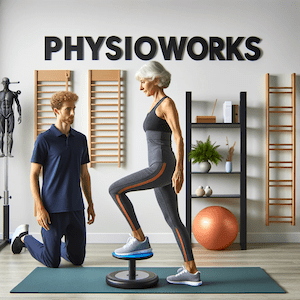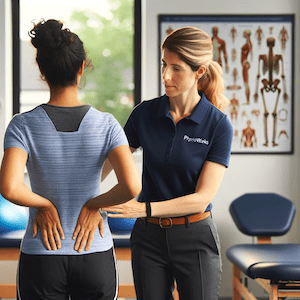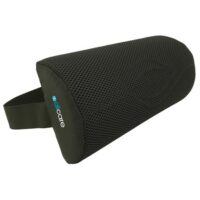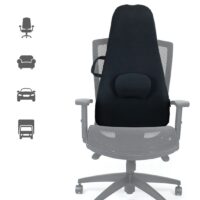Posture & Balance
Article by John Miller


Posture & Balance: An Introduction
Welcome to our guide on posture and balance, crucial components of physical health and well-being. This introductory page offers a glimpse into various aspects of posture and balance, each leading to a more in-depth article. Explore these topics to understand their importance and learn ways to improve your posture and balance.
Understanding Posture
Good posture is more than just standing up straight. It’s about aligning your body correctly to ensure efficiency and minimise strain. This section delves into the fundamentals of good posture, its benefits, and common misconceptions.
Read More: Posture
Importance of Balance
Balance is essential for daily activities and prevents falls. This article explores the mechanics of balance, its role in overall health, and practical tips for enhancing balance at any age.
Read more: Balance
Posture and Mental Health
Your posture can impact your mental health. Learn how maintaining good posture can boost confidence, reduce stress, and positively influence mood.
Exercises for Better Posture
Improving your posture is achievable with the right exercises. This guide provides a range of exercises designed to strengthen the muscles responsible for maintaining good posture.
Read more: Posture Correction

Posture at Work
The way you sit or stand at work can significantly affect your posture. This section offers advice on setting up an ergonomic workspace and maintaining good posture throughout the workday.
Read more: Sitting Posture
Posture and Ageing
As we age, maintaining good posture becomes even more important. Explore the challenges and tips for keeping a healthy posture in later years.
Read more: Posture
Technology and Posture
The rise of technology has impacted our posture. Learn about the effects of prolonged device usage and how to mitigate them for better posture health.
Read more: Text Neck
Balance Disorders
Understand the various balance disorders that can affect people of all ages. This article covers symptoms, causes, and treatment options for common balance disorders.
Read more: Balance Disorders
Balance Training Techniques
Balance training isn’t just for athletes. Discover techniques and exercises that anyone can do to improve their balance, from simple at-home exercises to more advanced routines.
Frequently Asked Questions
For more information or to start your posture or balance improvement journey, don’t hesitate to consult a physiotherapist. They’re equipped with the knowledge and tools to guide you towards better posture and balance, and consequently, better health.
Rochedale - Call 38410277
Book Online: RochedaleSalisbury - Call 32751044
Book Online: SalisburySandgate - Call 32691122
Book Online: SandgateArticle by John Miller
Posture FAQs


Your Guide to Better Posture
Maintaining good posture is crucial for overall health and well-being. Poor posture can lead to a host of issues, including back pain, reduced mobility, and even long-term health problems. This FAQ page addresses common questions about posture, providing insights and tips to help you improve your posture and enhance your quality of life.
Why is Good Posture Important?
Good posture helps you stand, walk, sit, and lie in positions that place the least strain on supporting muscles and ligaments. It keeps bones and joints in correct alignment, reducing the risk of injury and discomfort. Learn more about the benefits and reasons for maintaining good posture in the following articles:
- Why Posture Matters: Discusses the significance of good posture and its impact on overall health.
- Health Benefits of Good Posture: Explains the various health benefits of maintaining correct posture.
- Posture and Pain Prevention: Highlights how good posture can prevent common aches and pains.
How to Improve Your Posture?
Improving your posture involves strengthening the muscles that support your spine and developing new habits for standing, sitting, and lying down. Here are some practical steps and exercises to help you improve your posture:
- Posture Exercises: A list of exercises specifically designed to improve posture.
- Tips for Better Posture: Practical tips and techniques to incorporate into your daily routine.
- Ergonomic Advice: Guidance on how to set up your workspace and living areas to support good posture.
What Are the Effects of Poor Posture?
Poor posture can lead to various negative health outcomes, including chronic pain, reduced flexibility, and even respiratory issues. Understanding these effects can motivate you to make positive changes:
- Consequences of Poor Posture: Details the health risks associated with poor posture.
- Posture and Back Pain: Explains the connection between poor posture and back pain.
- Posture and Overall Health: Discusses how poor posture affects various aspects of your health.
Who Can Help with Posture Improvement?
Physiotherapists are trained to assess posture and develop customised treatment plans to improve it. Learn more about how a professional can help:
- Physiotherapy for Posture Improvement: Explains the role of physiotherapy in enhancing posture.
- Choosing the Right Physiotherapist: Fnding a physiotherapist who has a special interest in posture correction.


Conclusion
Improving and maintaining good posture is essential for your overall health. By following the tips and exercises provided, you can reduce pain, enhance your physical performance, and prevent future health problems. If you need professional help, don't hesitate to consult a physiotherapist.
Rochedale - Call 38410277
Book Online: RochedaleSalisbury - Call 32751044
Book Online: SalisburySandgate - Call 32691122
Book Online: SandgatePosture FAQs
- Why is good posture important? Good posture keeps bones and joints in correct alignment, reducing the risk of injury, pain, and long-term health problems. It also improves breathing and circulation.
- How can I improve my posture? You can improve your posture by doing specific exercises, being mindful of your body positions, and setting up an ergonomic workspace. Regular check-ups with a physiotherapist can also help.
- What are the signs of poor posture? Common signs include rounded shoulders, a forward head position, and back or neck pain. You may also experience fatigue and reduced flexibility.
- Who can help me with my posture? A physiotherapist can assess your posture and create a personalised treatment plan. They can teach you exercises and techniques to improve your posture.
- Where can I find resources to improve my posture? Resources are available on the PhysioWorks website, including articles on posture exercises, tips for better posture, and ergonomic advice.
- When should I seek professional help for my posture? If you experience persistent pain, discomfort, or find it challenging to maintain good posture on your own, consult a physiotherapist.
Follow Us for Free Tips
Stay updated with the latest tips on posture and overall health by following us on our social media platforms. We regularly share practical advice, exercises, and health information to help you maintain good posture and improve your well-being. Don't miss out on valuable insights!
Related Articles
- Back Pain – Causes, Treatment & Prevention Discover the common causes of back pain and effective treatment options.
- Neck Pain – Causes, Treatment & Prevention Learn about neck pain causes and how to treat and prevent it.
- Ergonomics: How to Set Up Your Workspace Tips for creating an ergonomic workspace to support good posture.
- Core Strengthening Exercises for Better Posture Strengthening your core can significantly improve your posture.
- Lumbar Support: Benefits and Best Products Explore the benefits of lumbar support and top product recommendations.
- Yoga for Posture Improvement Incorporate yoga poses into your routine to enhance your posture.
- Pilates for Posture Correction Pilates exercises that focus on posture correction and alignment.
- The Importance of a Proper Mattress for Posture How choosing the right mattress can support your spine and improve posture.
- Tips for Reducing Desk Job-Related Posture Issues Address common posture issues related to long hours at a desk job.
- Stretching Routines to Improve Flexibility and Posture Incorporate stretching routines to enhance flexibility and support better posture.
- Mayo Clinic: Posture Matters: Explains the importance of good posture and how to achieve it.
- Harvard Health: Tips to Improve Your Posture: Offers practical tips for better posture.
- WebMD: The Importance of Posture: Discusses why posture is crucial and how to maintain it.
Each of these articles provides valuable insights and practical tips to help you maintain and improve your posture, ensuring you stay healthy and comfortable.

























